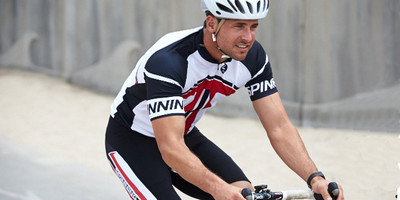By Kate Amos Part one of this
series explored some tips for getting the most out of your pre-workout routine to ensure that your body is working at full capacity. While it’s true that “it’s not about the
bike,” keeping your bike in good working order goes a long way towards ensuring happy, stress-free rides.
Avoid the Pinch
The first mistake to avoid in bike maintenance is not taking good care of your tires. Most bike tires feature a wire bead that hooks into the rim of the wheel. The tire itself is not filled with air; rather, a rubber tube is inflated and held against the rim by the tire. That air is the only thing between you and the ground, so regularly checking and maintaining your tubes and tires is perhaps the most important element keeping your bike maintained. Start by purchasing a floor pump, then using it at least twice a week to ensure that your tires are inflated to the proper pressure (see your tire’s manufacturer website for the recommended pressure—it varies with tire size and rider weight and may be lower than you expect). This helps to avoid “pinch” flats, which occur when the tube is pinched between an object on the ground and the hard metal of the rim, leaving a tell-tale “snakebite” hole pattern in the tube.If you do get a flat, first determine the cause by inspecting both the inside and outside of the tire. In addition to the tube, using both visual and physical inspections, running your fingers across the length of the tire to check for debris (use caution on this step glass shards are likely to be present). Once you find and remove the problem, you can either replace the tube or patch it with some rubber cement to get back on the road.
Avoid the Brakes Rubbing
Another common mistake to avoid is allowing your brakes to rub on your rims. The space between the brake pad and the rim is quite narrow to ensure you have instant stopping power on your bike, but some contact between these two can occur, slowing you down and ruining your ride. Check your brakes by lifting the bike and spinning the wheels. They should rotate freely without any contact between the brake pad and the rim. If the brake is rubbing, first check that the wheel is not crooked in the frame by opening the quick release and re-inserting the wheel so that it is straight within the fork or rear triangle. Another trouble spot is the calipers—both should be centered, not knocked to one side or the other. Additionally, most modern brakes have a small quick release that allows riders to easily remove the wheel with a fully-inflated tire, so always make sure these quick releases are set to the “closed” position before you head out the door. Finally, a wheel that is “out of true” can cause brake rubbing, so if you notice a distinct side-to-side wobble in your wheel when you rotate it, it’s time for a trip to your friendly mechanic at your local bike shop for a new one.
Maintain the Chain
A third mistake many new riders make is not properly maintaining their chain. Chains require regular cleaning and lube, especially if you are riding in harsh conditions such as rain, sand or snow. Chains can be cleaned with a quick pass of the hose and a paper towel, or you can invest in a special chain-cleaning tool that will really pull the grime out. Once the chain is clean, do not forget to re-apply lubricant! Be sure to wipe off any extra lube, though, according to manufacturer specifications so that your chain does not attract any extra dirt or debris. This not only keeps the chain in good working order, but also helps to extend the longevity of the entire drivetrain.
Try DIY Maintenance
Finally, the biggest mistake most new riders make is not learning to maintain their own bike at home. While certain problems can only be addressed by a certified mechanic using expensive specialty tools, many jobs are well within reach of the home mechanic, especially with resources like instructions online and YouTube videos. Keeping air in your tires, your brakes in proper alignment, and your chain properly lubricated and clean are just a few easy things you can learn to do at home. Not only will you save you time and money at the shop, but you’ll also be well-acquainted with the unique features of your own machine and will be more able to spot and address small issues before they become big problems.For more riding tips,
subscribe to our newsletter!

